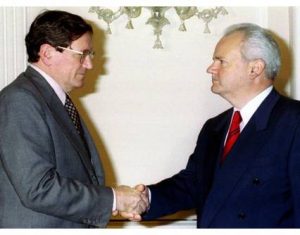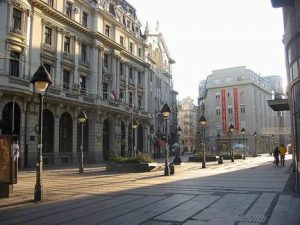The Case of the US Cultural Center in Belgrade
by John H. Brown
With all of the news accounts of the late diplomat, Richard Holbrooke’s exploits, this is one that has heretofore been overlooked by the world’s media.–Ed.
Richard Holbrooke has died. At a time when many are grieving the loss of a temperamental but dedicated diplomat, one episode of his work in the Balkans — that explosive and often forgotten corner of Europe — is worth bringing to light.
Here is this “Footnote to History” (it deserves to be capitalized): Thanks to an unwritten agreement between Holbrooke and Serbian strongman Slobodan Milosevic, the American Cultural Center in Belgrade, closed by order of the U. S. Government through its now-defunct United States Information Agency in the mid-1990s, was reopened not long after the 1995 Dayton Peace accord — with Milosevic footing the bill!
As the Public Affairs Officer (PAO) at the U. S. Embassy in Belgrade in 1995-98, I was present at this re-creation of a key element in American engagement (to use a word much favored by the Obama administration’s public-diplomacy team) in that long-suffering part of the world — a five-storey cultural center located in the heart of the Serbian capital with books, films, and lectures freely available to local audiences. During the Cold War, such worldwide centers, run by the USIA (United States Information Agency) were an admirable, and tangible, symbol of US interest in other countries — and of the openness of American society.
I must rely on my memory, never utterly reliable, to tell the story of how Center reopened its doors, due to the largesse of the “Butcher of the Balkans.” In ordinary circumstances, I would wait until getting hold of the lengthy unclassified cable I drafted (but did not keep, for security reasons) on the matter, but with the current focus on Holbrooke — that able and insufferable but very human being — I thought I should bring this story to public attention, if only to document more fully his life and accomplishments — and for readers of this blog to correct me if my remembrances of this event contain inaccuracies.
Here’s the story:
Months after the Dayton Peace Accord in 1995, Holbrooke — as a private citizen named special envoy to the Balkans by President Clinton after leaving his post of Assistant Secretary of State for European Affairs (1994-1996) — returned to Belgrade on numerous occasions to deal with the tense Kosovo situation (Kosovo, a “province” of the Serbian Republic in the former Yugoslavia, wanted its independence from Serbia or, to be more legalistic, from the Federal Republic of Yugoslavia (FRY, comprising Serbia and Montenegro since its inception in April 1992). In contrast to his Dayton ceasefire, Holbrooke was not successful in finding a solution to the Serbian-Kosovar nightmare, despite many meetings with Slobodan Milosevic.
 |
| Holbrooke and Milosevic meeting in 1998 |
At one of these meetings, Serbia’s blunt cigar-smoking head gangster Slobo — as he was called by both Americans and Serbs — accompanied by his Foreign Minister, Milan Miliutinovic (eventually not found guilty of war crimes International Criminal Tribunal for the Former Yugoslavia), asked the equally blunt Holbrooke (known as “The Bulldozer” in the Balkans), “Why did you close the American Center?” Miliutinovic, ever the elegantly dressed, somewhat effeminate, gentleman and former Ambassador to Greece who was more “cultivated” than the thuggish-looking Milosevic, made clear he was enamored of the Center. Holbrooke replied that the Center had been closed “for budgetary reasons.”
I was not an actual witness to this exchange, given that my job was press and cultural affairs, not closed-doors negotiations, but an Embassy colleague revealed its contents to me soon after it took place.
Regarding the closing of the Center, which had played a prominent role in Belgrade cultural life for decades, Holbrooke was actually telling the truth: In the 90s, after the collapse of communism, during the post-Cold euphoria characterized by intellectual illusions about the “end of history,” USIA and its cultural centers were, to use inside-the-Washington-beltway jargon, put on the back-burner. Many centers were closed throughout the world, and the Agency was consolidated into the State Department in 1999.
In my job as PAO Belgrade — and this is one of my greatest regrets as a former Foreign Service officer — I had implemented headquarters’ decision to close down the Belgrade Cultural Center soon after I arrived at the Serbian capital, replacing it with a minuscule “Information Research Center” inside Embassy walls that was meant to communicate “electronically” to “target audiences.”
 |
| Cika Ljubina ulica today (at the corner with Knez Mihajlova ulica) with the former USIS Center in the background. The building today houses the Spanish center Instituto Cervantes de Belgrado. |
And now comes the most intriguing and memorable part of the Holbrooke-Milosevic exchange: In response to Holbrooke’s candid admission of the USG’s lack of funds to keep the Center open, Milosevic said, “If you can’t afford it [the Center], I’ll pay for it.” (Meanwhile, pushed by the State Department and a pro-Kosovo member of Congress, the crash-strapped USIA, under the PAO’s direction in the field, was working on the establishment of a cultural center in Pristina, the capital of Kosovo).
Why did Milosevic want the American Center to reopen? I was never told the reasons, but doubtless he wished, after the Dayton peace talks, to obtain “official” recognition from the United States by means of the renewed presence of a prominent American establishment in downtown Belgrade (FRY was not officially recognized by the USG, even though the United States maintained a large embassy in the Serbian capital; the head of the US diplomacy mission was not an ambassador, but a chargé d’affaires). In an email, a former Foreign Service officer familiar with Central Europe and the Balkans offered other reasons for Milosevic’s interest in the Center: “A little voice in me asks whether the Serbs had wired the building and collected an intelligence bonanza about their own dissidents that they were reluctant to lose. But more likely they missed the nice old place they remembered.” That last sentence rings true to me: It should be remembered that Milosevic, when he worked as the head of Beobanka in the late 70s, had often traveled to New York, and spoke an accented Slavic English (I remember his rolling “rs”) that was still more American than British, especially when he used USA colloquialisms of a not refined nature. In fact, Milosevic “liked” America and its popular culture, as I could tell when watching him interact with Americans. He thought, I’d venture to say, that Americans were tough guys, as opposed to flaky Europeans.
Not long after the Holbrooke-Milosevic meeting, I was told by my Embassy superiors to go to the FRY agency dealing with diplomatic missions and inform it of Milosevic’s open-the-American-Center decision. I dutifully did so and, during a not unpleasant conversation with a functionary sitting below a framed photograph of Slobo, it was confirmed that the American Center would indeed be provided to the USG free of charge, which had certainly not been the case before — I can’t remember exactly what the exact yearly rent had been, but it was a considerable sum.
The American Center thus reopened, after having earlier given its book collections away, including to recipients in Kosovo. Some of its floors were eventually occupied, rent-free, by USAID, not exactly part of Slobo’s secret police. Meanwhile, I helped arrange for B-92, the dissident radio station at the time, to set up an “Internet Cafe” on one of the Center’s floors, using funds provided by USIA’s “Democracy Commission.”
So a war criminal ended up subsidizing an American “propaganda” establishment, equipped with the latest computer technology, and housing an anti-Milosevic media outlet to boot. Thank you, Mr. Holbrooke.
I’m surprised that the American media, which followed Holbrooke wherever he went —”What’s the most dangerous place in the Balkans?” the joke went. Answer: “between Dick Holbrooke and a TV camera”— did not pick up on the unusual Cultural Center-Milosevic connection. Needless to say, I did not volunteer information about this oral agreement to the press. It would certainly have made an attention-grabbing headline: “Bulldozer-Butcher Deal: Slobo Blood Money Bankrolls Former Belgrade US-Supported Freedom Bastion,” but public knowledge of this arrangement would not necessarily have placed the US Government (or Mr. Holbrooke) in a favorable light.
End of story: The Belgrade Cultural Center was vandalized at the time of the NATO bombings in Belgrade in 1999 and ended its operations. Today, its work is (somewhat) continued by “American Corner Belgrade,” which according to its homepage was “created to help increase mutual understanding between Serbia and USA. AC Belgrade was founded on May 16, 2003, as a result of cooperation between Belgrade City Library & US Embassy. On October 17, 2006, American Corner was reopened at its new location in Cultural Center Dom Omladine (“House of Youth”). American Corner Belgrade is one of the 7 American Corners in Serbia and one of the 400 Corners in over 60 countries world wide.”![]()
This article appeared in the Huffington Post in a slightly different format. It is re-published here with the kind permission of the author.

